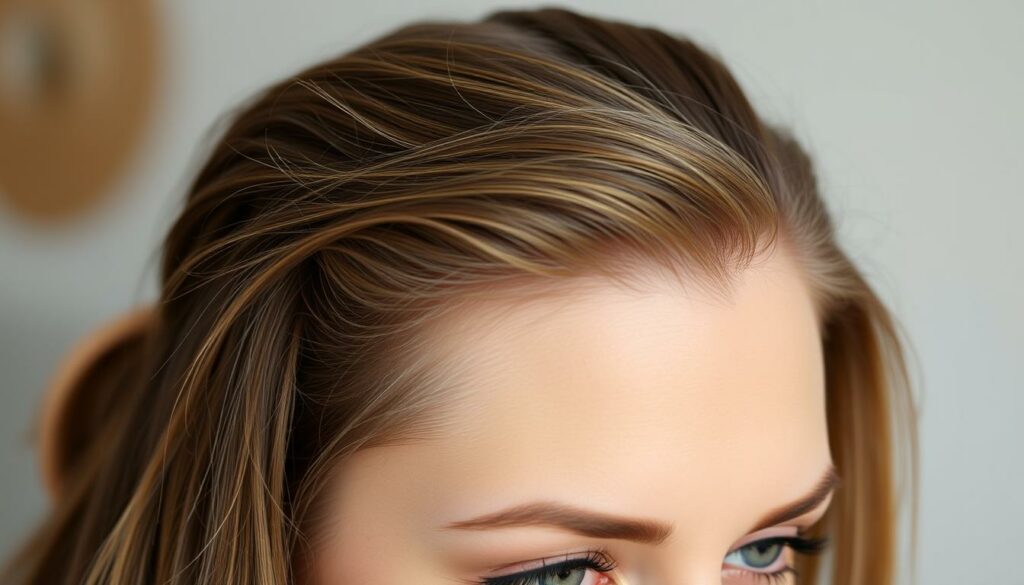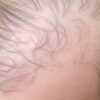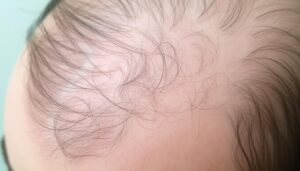Girls and women do have hairlines, just like men. But, the female hairline looks different. It has unique features that make it stand out. We’ll look into these differences, clear up myths, and talk about what shapes a woman’s hairline.

Key Takeaways
- Girls and women do have hairlines, but they often display different patterns and characteristics compared to male hairlines.
- The female hairline is typically more rounded, with a softer, more feminine appearance.
- Factors such as genetics, ethnicity, and hormonal changes can influence the shape and density of a woman’s hairline.
- Understanding the nuances of female hairlines can help women embrace and enhance their natural beauty.
- Proper haircare, styling techniques, and lifestyle choices can help maintain the health and appearance of a woman’s hairline.
Introduction to Female Hairlines
The topic of female hairlines is often overlooked or misunderstood. Many women struggle with unrealistic beauty standards and insecurities about their natural feminine hairlines. We’ll provide an overview of the unique features and importance of understanding do girls have hairlines.
Overview of the Topic
The hairline is key in defining a person’s facial features and overall look. While men’s hairlines get a lot of attention, female hairlines are often ignored. It’s time to highlight this often-overlooked part of women’s hair and beauty.
Why Understanding Female Hairlines Matters
Knowing about feminine hairlines helps women embrace their natural beauty and boost their self-confidence. By understanding the diversity of do girls have hairlines, women can feel more confident and comfortable in their own skin. They won’t feel pressured to meet unrealistic beauty standards.
Also, knowledge about female hairlines helps women make better choices about hairstyles and haircare. This leads to better hair health and a stronger sense of self-acceptance.
Next, we’ll explore the anatomy of female hairlines, compare them with male hairlines, and discuss common concerns and styling options for women.
The Anatomy of a Female Hairline
To understand female hairlines, we need to look closely at their anatomy. We’ll explore how they shape, texture, and density change. This will give us deep insights.
Defining the Female Hairline
The female hairline marks where hair starts on the forehead. It’s softer and curves gently, unlike men’s hairlines. This gentle framing can greatly affect a woman’s look and confidence.
Factors Influencing Female Hairlines
Many things affect a female hairline. These include:
- Genetics: Your hairline’s shape, density, and texture come from your genes. These can differ across ethnicities and families.
- Hormonal Changes: Hormone changes, like during puberty, pregnancy, or menopause, can make the hairline change. These changes can be temporary or last longer.
- Age: As women get older, their hairline might move back or thin. This changes how the forehead and face look.
- Hairstyles and Haircare Practices: Hairstyles like tight ponytails or braids, and harsh products, can stress the hairline. This can lead to thinning or breakage over time.
Knowing what shapes a female hairline helps us value its diversity and flexibility. This feature is key to our look.
Do Girls Have Hairlines?
Girls and women do have hairlines, even if they look different from men’s hairlines. These lines mark the start of hair growth and are key to framing the face. They are a big part of a woman’s look.
Hairlines are important for a person’s look. Girls with hairlines might not get as much attention as men, but they are crucial. They help shape a woman’s style and confidence.
The shape and look of a girl’s hairline affect her hairstyle and how she sees herself. Knowing about do girls have a hairline helps women see and love this part of their look more.
| Feature | Male Hairline | Female Hairline |
|---|---|---|
| Shape | Typically straighter and more angular | Often softer, more rounded, and can be slightly higher on the forehead |
| Density | Generally thicker and more pronounced | Typically finer and less dense |
| Positioning | Slightly lower on the forehead | Slightly higher on the forehead |
Knowing about girls with hairlines helps people accept and celebrate their looks. It makes it easier to find styles that suit their face and hair.
“Embracing your natural hairline is an important step in self-acceptance and confidence. Every person’s hairline is unique and beautiful in its own way.”
Differences Between Male and Female Hairlines
There are clear differences in hairlines between men and women. Knowing these differences helps people see the special traits of their own hairline. It shows how it fits with gender-specific patterns.
Shape and Pattern
Men’s hairlines are often sharp and angular, forming a clear “V” or “M” shape at the temples. Women’s hairlines are softer and more curved, blending smoothly from the forehead to the hairline.
Texture and Density
The feel and thickness of hair at the hairline differ by gender. Women’s hairlines usually have a finer, more delicate feel, with more hairs. This makes the transition from forehead to hairline look natural. Men’s hairlines seem bolder, with coarser, less dense hair.
“The subtle differences in hairline shape, pattern, texture, and density are what contribute to the distinct feminine and masculine aesthetics we observe.”
These hairline differences come from biology and affect how we see gender and identity. Knowing these differences helps people value the variety in hairline features. It lets them accept their unique feminine or masculine traits.
Common Hairline Concerns for Women
Women often face unique challenges with their hairlines. A healthy, defined hairline shows beauty. But, thinning or receding hairlines are common issues. Knowing these problems and their causes helps in finding solutions.
Thinning or Receding Hairlines
Thinning or receding hairlines are big concerns for women. Many factors can cause this, like hormonal changes, stress, genetics, and certain hairstyles or treatments. As we get older, our hairline might shift slightly. But sometimes, these changes can be more noticeable and worrying.
Women with thinning or receding hairlines might see their forehead getting wider. They might also notice less hair at the temples or a higher hairline. These changes can really affect one’s confidence and look.
“My hairline has always been a source of insecurity for me. I’ve tried various treatments, but it’s been an ongoing battle. Understanding that this is a common issue for women has been really reassuring.”
There are many strategies and solutions for female hairline concerns. From making lifestyle changes to trying special treatments, there are ways to keep your girls hairline looking healthy and young. The important thing is to find out what’s causing the issue and work with a trusted professional to create a plan.
Hairline Changes During Different Life Stages
Throughout a woman’s life, her hairline changes due to natural shifts in hormones. These changes can affect the look and health of her hairline. Understanding these changes helps women manage their hair better.
Puberty and Hormonal Shifts
At puberty, girls see changes in their hairline as their hormones change. This can make the hairline wider or lower. These changes are normal and part of growing up.
Pregnancy and Postpartum Changes
Pregnancy affects a woman’s female hairline. High estrogen levels make the hairline look fuller. But after giving birth, hormone levels drop, causing hair to fall out and look thinner. This is common and called postpartum alopecia.
Women should know these changes are normal. Being aware helps them take care of their hairline. This way, they can feel confident and beautiful at all stages of life.
Cultural and Ethnic Variations in Female Hairlines
Many people think all women have the same hairline shape. But, the truth is, female hairlines vary a lot across cultures and ethnic groups. This shows the wide range of physical traits found in women around the world.
In many Asian cultures, women often have a lower, more rounded hairline. This shape frames the face in a soft, delicate way. In parts of Africa, women may have a higher, more angular hairline. This style shows a bold, confident look. The hairlines of Latina women can vary from the classic widow’s peak to a slightly curved, symmetrical shape.
These differences in feminine hairlines show the unique heritage and genes of women. They add to the diversity and richness of the female experience. It’s important to accept and celebrate these differences. This helps challenge societal norms and builds a more inclusive, empowered view of girls with hairlines.
| Ethnic Group | Typical Feminine Hairline Characteristics |
|---|---|
| Asian | Lower, more rounded |
| African | Higher, more angular |
| Latina | Widow’s peak to slightly curved, symmetrical |
By understanding and valuing the diverse female hairlines, we can work towards a more inclusive and empowering view of women’s beauty and identity. This celebration of diversity challenges old norms. It also inspires a new generation of girls with hairlines to be proud of their unique features.
Conclusion
When it comes to hairlines, there seems to be a misconception that only men have defined ones, while women do not. However, this is far from the truth. Both men and women have hairlines, but there are differences in how they are typically perceived and characterized.
If you find yourself not likeing your hairline, then scalp micorpigmenation at Scalp Masters is the place for you!
Traditionally, a masculine hairline is described as having a more defined and square shape, often sitting lower on the forehead. On the other hand, a feminine hairline is commonly seen as softer, with a gentle curve and located slightly higher. Do you want or know anybody that wants a softer or different hairline? SMP could be the perfect fix you are looking for. Contact us today for a free consulation!










